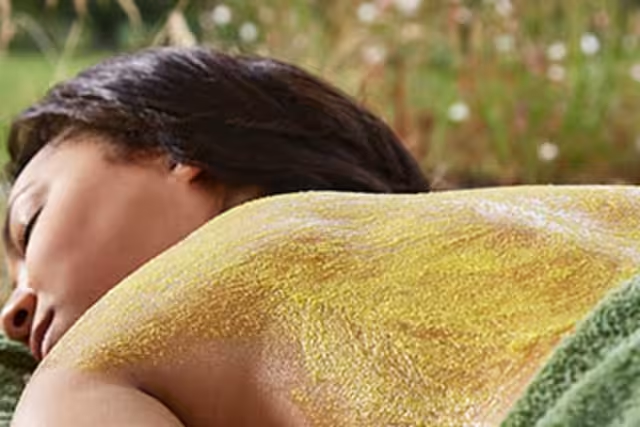Body wraps
Part of the Spabreaks.com Spa Treatment Guides
Slimming, detoxifying, relaxing, nourishing - body wraps are some of the most intensely therapeutic spa treatments on the market. Wraps are often preferred by those who have been to a spa before, but there’s no reason a first time spa goer shouldn’t have a body wrap either. Usually at least an hour long, they are a wonderful way to relax and unwind. It is advised that you drink lots of water and herbal teas after your treatment to continue the detox process and stay hydrated. It is also recommended that you use spa facilities before the treatment, especially the thermal experiences, to help boost circulation and prepare the skin to encourage spa products to work.

What is a body wrap?
A full body treatment is where masks and moisturisers are applied to your skin before you are wrapped up in sheets, foil or towels to help the products absorb into the skin. The details and purpose of a body wrap vary from one spa and one treatment to the next, with each destination adding its own elements to really personalise it.

What are the benefits of a body wrap?
Depending on the type of wrap you are having, there are a wide range of benefits and to some extent they all apply to body wraps in general. These include, but are not limited to:
- Exfoliation and removal of dead skin cells
- Hydration and moisturising
- Relaxation
- Slimming and toning
- Detox
Types of body wrap treatments
There’s a wide variety of body wraps available to choose from, and each spa puts its own variation on treatments, so this is not an exhaustive list, but a guide to some of the broad categories that body wraps can fall into:
Seaweed wrap: seaweed wraps are especially good for helping with water retention, detox and cellulite. Seaweed from the Hebrides is especially popular in these treatments.
Algae wrap: using warm algae mud, algae wraps help to get rid of dead skin cells and soften the skin. The algae is filled with vitamins and nutrients and the serum nourishes and protects it – it’s really good for hydrating the skin.
Hydrating wrap: hydrating and moisturising wraps can come in lots of different forms with a variety of hero ingredients. Using rich oils and creams, they help to hydrate the skin, support deep relaxation, restore skin elasticity and are excellent for post holiday!
Chocolate body wrap: chocolate body wraps have a wonderful sense of indulgence about them and usually use nourishing cocoa butter, soy and/caffeine elements as part of the treatment, which are good for metabolism, moisturising and relaxing.
Slimming body wrap: it’s important to understand that body wraps will not help you to lose weight long term, but they can help with water retention and toning the skin. Because of the detox element, they can be helpful and encouraging as part of a healthy diet. Effective essential oil ingredients include things like grapefruit, which is skin-toning and detoxifying, ginger and pepper can have a warming effect which helps to activate circulation, caffeine is sometimes present and helps flush toxins from the body, while the combination can help to reduce fatty deposits and cellulite.
Mud wrap: mud treatments draw on some of the most traditional elements of the spa experience. Tailored to personal needs, they are typically slimming and detoxifying and also help to improve circulation. They can also be moisturising, help to de-stress and ease muscular aches and pains as well as being an anti-inflammatory.
Paraffin body wrap: this is where heated wax is brushed over the body to soothe the muscles, draw out dirt, remove dead skin and leave skin feeling clean and soft. Essentially, the ultimate steam - Champneys do it brilliantly.
Thalasso body wrap: Thalassotherapy forms a variety of spa experiences based on the healing powers of sea water. Thalasso wraps incorporate elements of that, including seawater and seaweed, which help to slim, tone and hydrate the body.

What happens during a body wrap?
As with all things, this will really vary from one treatment and one spa to the next. However, as a rule of thumb, a body wrap usually includes the following steps:
- Dress/undress and relax: at the start of the treatment your therapist will take you to the treatment room and leave you for a few moments to undress and settle under a towel provided on the treatment bed.
- Body scrub: most body wraps begin with a full body scrub to get rid of dry skin, cleanse, and boost circulation. It is also an excellent way to start the relaxation process.
- Rinse: often treatment rooms will have showers in them so you can rinse the scrub off yourself, and you will be given time to do that. Alternatively, the therapist may remove the product with warm, damp towels instead.
- Body mask and wrap: the mask is the main event and is a product that’s applied to the whole body before you are wrapped in a sheet to let the products work their magic.
- Relax: then you will be given time to simply relax and unwind. There may be relaxing music and candles, and sometimes this time is used to give you a scalp massage to help with the relaxation process.
- Unwrap: when it’s time to remove the wrap you may again be asked to shower or the therapist will remove products again with warm towels.
- Moisturise: body wraps are usually completed with a finishing application of a moisturising oil or cream so you can leave feeling fully hydrated.
Choose this if you want too...
- Nourish and hydrate the skin
- Detox
- Exfoliate and remove dead skin cells
- Deeply relax
- Aid skin tone

Average price of a body wrap
All spa treatments can really vary in cost depending on where you have them, what they involve, which products are used and how long the treatment is. A body wrap tends to be at least 60 minutes long, making it a really enjoyable, meaningful spa experience. For this reason they can range anywhere from £60 to well over £100, although for a more precise idea it’s best to look at the venues you’re interested in visiting.

Body wrap aftercare
Aftercare will also depend enormously on the type of body wrap that you have, but the essential rules to stick to are:
- Drink plenty of water to rehydrate.
- Try to avoid stimulants such as caffeine and alcohol, which will further dehydrate you and counter the effects of the treatment.
- It’s best to use the spa facilities before your body wrap so you don’t wash off all the wonderful products - try to leave them on to continue to work their magic.
- If you can avoid applying make-up or perfumes for the rest of the day then it’s an added bonus for your skin.
What to wear during a body wrap treatment?
What to wear/not wear during a body wrap is one of the most common questions when it comes to this kind of full body treatment. Usually the spa will provide you with paper underwear so that products do not get onto your clothing, and you will be asked to take your gown off, put on the underwear and settle under a towel before the therapist comes into the room. However, you can also choose to wear your own underwear or bikini bottoms during the treatment. Your therapist will only ever uncover the area of your body that they are working on and if you have any questions feel free to ask your therapist at any time.
You Might Also Like

Body polishes
Body polishes and body scrubs can be invigorating, excellent skin prep before or after a holiday and can help with detox. As your skin is your largest detox assisting organ in the body, a body scrub can work wonders.
Read our guide
Facials
Facials are a classic part of a spa experience, and while massages are the most regularly booked spa treatment, a facial can be just as relaxing.
Read our guide
Rhassoul and mud treatments
Mud baths, rhassouls/rasuls and mud treatments come in a number of different guises, and have been cleansing and healing practices for thousands of years. Introduced to different cultures around the world with their own variations, but largely operating on the same theme.
Read our guide